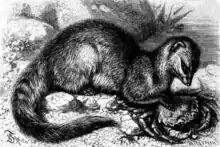Crab-eating mongoose
The crab-eating mongoose (Herpestes urva) is a mongoose species ranging from the northeastern Indian subcontinent and Southeast Asia to southern China and Taiwan. It is listed as Least Concern on the IUCN Red List.[1]
| Crab-eating mongoose | |
|---|---|
 | |
| Scientific classification | |
| Kingdom: | Animalia |
| Phylum: | Chordata |
| Class: | Mammalia |
| Order: | Carnivora |
| Suborder: | Feliformia |
| Family: | Herpestidae |
| Genus: | Herpestes |
| Species: | H. urva |
| Binomial name | |
| Herpestes urva (Hodgson, 1836) | |
| Subspecies[2] | |
| |
 | |
| Distribution of the crab-eating mongoose | |
Taxonomy
Gulo urva was the scientific name proposed by Brian Houghton Hodgson in 1836 who first described the type specimen that originated in central Nepal. It is locally called 'urva'.[3]
Characteristics

The crab-eating mongoose is grey on the sides and dusky brown on neck, chest, belly and limbs. It has a broad white stripe on the sides of the neck extending from the cheeks to the shoulder.[3] It has white specks on the top of the head, its chin is white and its throat gray. Its iris is yellow. Its ears are short and rounded. It has webs between the digits. In head-to-body length it ranges from 47.7 to 55.8 cm (18.8 to 22.0 in) with a 28 to 34 cm (11 to 13 in) long bushy tail. Its weight ranges from 1.1 to 2.5 kg (2.4 to 5.5 lb).[4]
Distribution and habitat
The crab-eating mongoose occurs in northeastern India, northern Myanmar, Thailand, Peninsular Malaysia, Laos, Cambodia, and Vietnam. It is rare in Bangladesh. It has been recorded at altitudes from sea level to 1,800 m (5,900 ft).[1]
In Nepal, it inhabits subtropical evergreen and moist deciduous forests, and has also been observed on agricultural land near human settlements.[5] In India, it was recorded in Assam and Arunachal Pradesh.[6][7] In Bangladesh, it was recorded in the eastern forested hills in Sylhet and Chittagong areas.[4] In Myanmar, it was recorded in the Bumhpa Bum hills at up to 930 m (3,050 ft) altitude, in Hukawng Valley, Alaungdaw Kathapa National Park, Bago Yoma and Myinmoletkat Taung during surveys between 2001 and 2003.[8] In China's Guangxi, Guangdong and Hainan provinces, it was recorded in subtropical limestone forest during interview and camera-trapping surveys carried out between 1997 and 2005.[9]
Ecology and behaviour
Crab-eating mongooses are usually active in the mornings and evenings, and were observed in groups of up to four individuals. They are supposed to be good swimmers, and hunt along the banks of streams and close to water.[4]
Despite their common name, their diet consists not only of crabs, but also just about anything else they can catch, including fish, snails, frogs, rodents, birds, reptiles, and insects.[5]
Conservation
Herpestes urva is listed in CITES Appendix III.[1]
References
- Choudhury, A.; Timmins, R.; Chutipong, W.; Duckworth, J. W.; Mudappa, D.; Willcox, D. H. A. (2015). "Herpestes urva (errata version published in 2016)". IUCN Red List of Threatened Species. 2015: e.T41618A86159618. Retrieved 24 December 2019.
- Wozencraft, W.C. (2005). "Order Carnivora". In Wilson, D.E.; Reeder, D.M (eds.). Mammal Species of the World: A Taxonomic and Geographic Reference (3rd ed.). Johns Hopkins University Press. pp. 569–570. ISBN 978-0-8018-8221-0. OCLC 62265494.
- Hodgson, B. H. (1836). "Synoptical description of sundry new animals, enumerated in the Catalogue of Nepalese Mammals". Journal of the Asiatic Society of Bengal. 5: 231–238.
- Van Rompaey, H. (2001). "The Crab-eating mongoose, Herpestes urva". Small Carnivore Conservation (25): 12–17.
- Thapa, S. (2013). "Observations of Crab-eating Mongoose Herpestes urva in eastern Nepal". Small Carnivore Conservation. 49: 31–33.
- Choudhury, A. (1997). "The distribution and status of small carnivores (mustelids, viverrids, and herpestids) in Assam, India". Small Carnivore Conservation (16): 25–26.
- Choudhury, A. (1997). "Small carnivores (mustelids, viverrids, herpestids, and one ailurid) in Arunachal Pradesh, India". Small Carnivore Conservation (17): 7–9.
- Than Zaw; Saw Htun; Saw Htoo Tha Po; Myint Maung; Lynam, A. J.; Kyaw Thinn Latt; Duckworth, J. W. (2008). "Status and distribution of small carnivores in Myanmar". Small Carnivore Conservation (38): 2–28.
- Lau, M. W. N.; Fellowes, J. R.; Chan, B. P. L. (2010). "Carnivores (Mammalia: Carnivora) in South China: a status review with notes on the commercial trade". Mammal Review. 40 (42): 247–292. doi:10.1111/j.1365-2907.2010.00163.x.
Further reading
- Menon, V. (2003). A field guide to Indian mammals. Penguin India, New Delhi
External links
| Wikimedia Commons has media related to Herpestes urva. |
